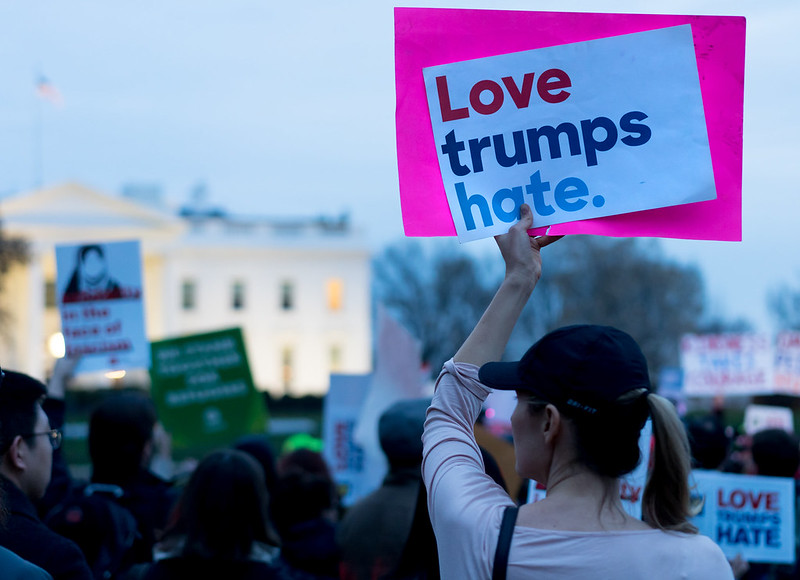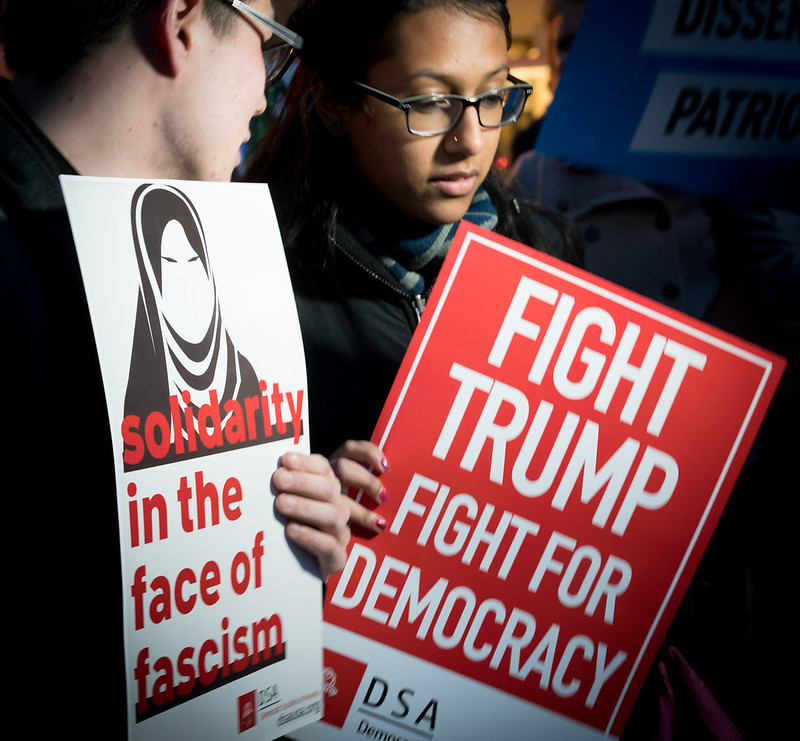
On April 22, President Trump issued a Presidential Proclamation temporarily suspending certain categories of legal immigration into the United States, targeting families and the relatively small number of workers who enter the U.S. each year on permanent, rather than temporary, visas.
The President incorrectly claims that yet another reduction in immigration is a critical step in protecting American workers and rebuilding the economy in the face of the global COVID-19 pandemic.
Instead, the proclamation will do nothing to help the economy and may actually hurt it. It will harm American citizens and permanent residents who have waited years to reunite with family members. It will punish employers who depend on permanent rather than temporary workers.
Most egregiously, it further enshrines the myth that immigrants are the enemy—wrapping that myth in more red, white and blue bunting than a Fourth of July parade.
President Trump and his key advisors, like Stephen Miller, have been chipping away at America’s immigration framework since Day One of the administration, issuing proclamations, executive orders and regulations at a dizzying pace that have done everything from banning Muslim travelers and immigrants, decimating the refugee program, ending DACA and eliminating asylum access for virtually everyone crossing the border between the U.S. and Mexico.
Asylum seekers and refugees have been specifically targeted, but the Trump machine has also gone after unaccompanied children, foreign students, highly skilled temporary workers and applicants for naturalization, among others, while mounting an enforcement campaign against undocumented immigrants that has been ruthlessly efficient in deporting thousands more people.
Much of this has been done under the cynical twin pillars of protecting America from terrorism and protecting the American worker—nimbly pivoting between the two as necessary to manipulate the dominant fear of the moment. The administration has shamelessly latched on to the global pandemic as a new justification for banning immigration, quickly moving from efforts to limit non-essential travel to travel bans to orders that are allowing DHS to ignore due process at the border.
Most recently, the Trump administration dragged the Centers for Disease Control and Prevention (CDC) into the immigration muck, issuing a new rule that allows the CDC director to “suspend” the introduction of persons into the United States to prevent the introduction of an infectious disease. The ensuing order banned persons entering the United States from Mexico and Canada without documentation, and has been used by DHS as a justification to ignore immigration law and summarily expel thousands of migrants—including unaccompanied children and asylum seekers—without following any of the laws requiring humanitarian screenings, screenings for trafficking of children or the legal procedures required to remove an individual from the United States.
The result has been chaos and tragedy, with the U.S. indiscriminately turning back mostly healthy people at the border—but also failing to screen for COVID-19 among deportees—leading to at least some outbreaks in Mexico and Central America attributed to persons exposed to infection while living in the United States.
There are real issues involved in managing an immigration system during a pandemic, identified by public health experts and migration experts—such as the need to release the vast majority of detained immigrants, closing the immigration courts or figuring out reasonable international travel and quarantine measures. But this is not where the administration chose to place its efforts.
Instead, mirroring the suspension language of the CDC order, President Trump initially promised to suspend all legal immigration to fight the pandemic and support the American worker. Within a few days, however, that initial tweet morphed into the new suspension order—which pays only passing reference to COVID-19—arguing instead that everything possible must be done to put Americans back to work, including temporarily suspending the entry of legal permanent residents.
The order is filled with exceptions, which means that many Americans may not notice this “pause” in immigration—but for U.S. citizens whose adult children or siblings were in line for a green card, or for the spouses and children of permanent residents, or for employers who have searched in vain for an American worker who meets the specific needs of a specific job, or for people from historically low immigration countries (many of them in Africa) who hope for the chance that a diversity lottery visa gives them to a new life in America, the consequences are real enough.
And even if you are not directly touched by this latest immigration move, the broader consequences are profoundly disturbing, as this is a clear end run around existing law governing legal immigration.
The anti-immigrant movement has been pushing for decades to reduce family immigration, eliminate the diversity visa and change up the way employment visas are distributed. They have been unsuccessful in changing the law for the last forty years, but in one fell swoop, the President has made many of their dreams come true.
He has pandered to the movement many times before, most notably in his Buy American Hire American executive order—issued almost three years to the day of the new Proclamation—which gave many government bureaucrats free rein to deny or delay numerous immigration applications for permanent or temporary workers based on nothing more than a gut feeling that an American might be able to fill that job. Buy America, Hire America has crept into many aspects of immigration adjudications—creating an increasing demand for redundant and irrelevant extra information, further prolonging the already slow and difficult process of bringing workers legally into the United States.

This latest effort to “protect” the American worker is based on similarly misguided and misinformed economic analysis. In fact, leading economists—including many Nobel laureates and former Republican and Democratic government officials—agree that immigration is a net positive for the American economy, that a robust immigration system increases jobs for native born Americans, and that wages are not harmed and may even be helped by immigration.
The sectors where immigrants are most likely to potentially compete with Americans for jobs are often the very sectors—agriculture, the service industry, health care work that doesn’t require a professional degree—that have a glut of jobs which Americans do not fill. And for the types of jobs targeted by the new proclamation, employers must go through a rigorous and lengthy process of proving that they were unable to find a qualified worker to fill the position.
Similarly, many of the family members precluded from entering the United States under the president’s proclamation often end up filling paid or unpaid caregiver roles, bolstering the economy while supporting their immediate families. All of them are only permitted to immigrate with a pledge from the U.S citizen or permanent resident that they will sponsor them, including pledging to support them economically if necessary. Thus, there is nothing gained economically from issuing this order.
But anti-immigration rhetoric has been a bedrock of the president’s approach to governing and maintaining his base. Given his disastrous leadership during the COVID-19 pandemic, he needs to show that he is looking out for America, and seems more than happy to build on his past successes in making immigrants the ultimate scapegoat.
He is further aided by the isolation and self distancing necessary to contain the coronavirus, which makes organizing the massive rallies and protests that marked his earlier anti-immigration efforts almost impossible. There’s a certain weariness in the public, too, brought on by so much bad news about COVID-19 and the president’s exhausting barrage of anti-immigrant actions, that makes it a little too easy to shrug our shoulders over this latest outrage. Immigration advocates are fighting on—but getting the public’s attention is harder these days.
Trump and his cronies know this. He is banking on slipping in changes that could have a profound long-term effect on our immigration system. The proclamation contains provisions that allow for renewal of the “temporary” suspension and possible extension to many temporary work visas. Similar provisions were placed in the Muslim and refugee bans, and the result has been a deeply entrenched administrative system that has whittled away at laws protecting immigrants from persecution and discrimination. The same is likely to happen here if we are not vigilant, adding this new ban to the list of immigration measures that can’t be tolerated.
We must continue, even in the midst of a pandemic, to push back, to protest virtually, and to use our power with elected officials (and in the 2020 election) to fight for a better America.
The Trump administration has proven time and again that it does not understand, or doesn’t care about, the value of a diverse, creative and multi-cultural nation.
All of us are truly in the fight to stop COVID-19 from destroying lives. Banning immigrants does nothing to further that fight and is a waste of energy, resources, human capital and good will that America cannot afford.
The coronavirus pandemic and the response by federal, state and local authorities is fast-moving. During this time, Ms. is keeping a focus on aspects of the crisis—especially as it impacts women and their families—often not reported by mainstream media. If you found this article helpful, please consider supporting our independent reporting and truth-telling for as little as $5 per month.





